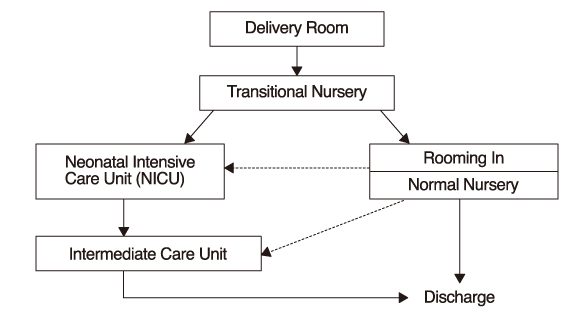J Korean Med Assoc.
2008 Aug;51(8):745-754. 10.5124/jkma.2008.51.8.745.
Management of Premature and Low Birth Weight Infants
- Affiliations
-
- 1Department of Pediatrics, Chonnam National University College of Medicine, Korea. yychoi@chonnam.ac.kr
- KMID: 2185934
- DOI: http://doi.org/10.5124/jkma.2008.51.8.745
Abstract
- Premature (gestational age < 37th week) and low birth weight (LBW, birth weight < 2,500g) infants are very sensitive to small changes in respiratory management, blood pressure, fluid administration, nutrition, and virtually all other aspects of care because of physiological immaturity. The most important principle in the care of those babies is the 'maximum observation and minimum handling' during their initial adaptation from intrauterine to extrauterine life. At birth, the measures needed to clear the airway, initiate breathing, care for the umbilical cord and eyes, and administer vitamin K are the same for term and normal weight infants. However, special care is required to maintain a patent airway and avoid potential aspiration of gastric contents. Additional considerations are needed for thermal control and monitoring of the heart rate, respiration, and nutrition. Safeguards against infection can never be relaxed. The effective care based on currently available evidence is best ensured through the implementation for standardized protocols for the care of those infants within individual nursery or neonatal intensive care unit (NICU). The need for regular and active participation by the parents in the infant's care during hospital stay, the need to instruct the monitor in at-home care of her infant, and the question of prognosis for later growth and development require special consideration. Effective discharge planning and follow-up visiting also promote continuity of care from hospital to home.
MeSH Terms
-
Birth Weight
Blood Pressure
Critical Care
Continuity of Patient Care
Eye
Follow-Up Studies
Growth and Development
Heart Rate
Humans
Infant
Infant, Low Birth Weight
Infant, Newborn
Intensive Care, Neonatal
Length of Stay
Nurseries
Organothiophosphorus Compounds
Parents
Parturition
Patient Discharge
Prognosis
Respiration
Umbilical Cord
Vitamin K
Organothiophosphorus Compounds
Vitamin K
Figure
Reference
-
1. Lee KG. Cloherty JP, Eichenwald EC, Stark AR, editors. Identifying the high-risk newborn. Manual of neonatal care. 2007. 6th ed. Philadelphia: Lippincott Williams & Wilkins;41–58.2. Ringer SA. Cloherty JP, Eichenwald EC, Stark AR, editors. Care of the extremely low-birth weight infant. Manual of neonatal care. 2007. 6th ed. Philadelphia: Lippincott Williams & Wilkins;78–85.3. Doherty EG, Simmons CF. Cloherty JP, Eichenwald EC, Stark AR, editors. Fluid and electrolyte management. Manual of neonatal care. 2007. 6th ed. Philadelphia: Lippincott Williams & Wilkins;100–113.4. Ellard D, Anderson DM. Cloherty JP, Eichenwald EC, Stark AR, editors. Nutrition. Manual of neonatal care. 2007. 6th ed. Philadelphia: Lippincott Williams & Wilkins;114–136.5. May G, Zaccagnini L. Cloherty JP, Eichenwald EC, Stark AR, editors. Discharge planning. Manual of neonatal care. 2007. 6th ed. Philadelphia: Lippincott Williams & Wilkins;164–175.6. Stoll BJ. Kliegman RM, Behrman RE, Jenson HB, Stanton BF, editors. The newborn. Nelson textbook of pediatrics. 2007. 18th ed. Philadelphia: Elsevier Saunders;675–682.7. Stoll BJ, Adams-Chapman I. Kliegman RM, Behrman RE, Jenson HB, Stanton BF, editors. The high-risk infant. Nelson textbook of pediatrics. 2007. 18th ed. Philadelphia: Elsevier Saunders;698–710.8. Chandra S, Baumgart S. Taeusch HW, Ballard RA, Gleason CA, editors. Temperature regulation of the premature infant. Avery's diseases of the newborn. 2004. 8th ed. Philadelphia: Elsevier Saunders;364–371.
Article9. Seri I, Ramanathan R, Evans JR. Taeusch HW, Ballard RA, Gleason CA, editors. Acid-base, fluid and electrolyte management. Avery's diseases of the newborn. 2004. 8th ed. Philadelphia: Elsevier Saunders;372–397.
Article10. Evans N, Seri I. Taeusch HW, Ballard RA, Gleason CA, editors. Cardiovascular compromise in the newborn infant. Avery's diseases of the newborn. 2004. 8th ed. Philadelphia: Elsevier Saunders;398–409.
Article11. Eichenwald EC. Taeusch HW, Ballard RA, Gleason CA, editors. Care of the extremely low-birth weight infant. Avery's diseases of the newborn. 2004. 8th ed. Philadelphia: Elsevier Saunders;410–426.12. Schanler RJ. Taeusch HW, Ballard RA, Gleason CA, editors. Enteral nutrition for the high-risk neonate. Avery's diseases of the newborn. 2004. 8th ed. Philadelphia: Elsevier Saunders;1043–1060.
Article13. Poindexter BB, Denne SC. Taeusch HW, Ballard RA, Gleason CA, editors. Parenteral nutrition. Avery's diseases of the newborn. 2004. 8th ed. Philadelphia: Elsevier Saunders;1061–1070.
Article14. Agren J, Sjörs G, Sedin G. Ambient humidity influences the rate of skin barrier maturation in extremely preterm infants. J Pediatr. 2006. 148:613–617.
Article15. Caple J, Armentrout D, Huseby V, Halbardier B, Garcia J, Sparks JW, Moya FR. Randomized, controlled trial of slow versus rapid feeding volume advancement in preterm infants. Pediatrics. 2004. 114:1597–1600.
Article16. McGuire W, Henderson G, Fowlie PW. Feeding the preterm infant. BMJ. 2004. 329:1227–1230.
Article17. Neu J. Gastrointestinal development and meeting the nutritional needs of premature infants. Am J Clin Nutr. 2007. 85:629S–634S.
Article18. Cattaneo A, Davanzo R, Worku B, Surjono A, Echeverria M, Bedri A, Haksari E, Osorno L, Gudetta B, Setyowireni D, Quintero S, Tamburlini G. Kangaroo mother care for low birth weight infants: a randomized controlled trial in different settings. Acta Paediatr. 1998. 87:976–985.
Article19. Lee DH. Newborn screening of inherited metabolic disease in Korea. Korean J Pediatr. 2006. 49:1125–1139.
Article20. Advisory Committee on Immunization Practice. American Academy of Pediatrics. American Academy of Family Physicians. Recommended immunization schedule for persons aged 0 to 6 years-United States 2008.
- Full Text Links
- Actions
-
Cited
- CITED
-
- Close
- Share
- Similar articles
-
- Clinical Evaluation of Postnatal Weight Gain in Premature and Low Birth Weight Infants
- Clinical Study of Prematurity and Low Birth Weight Infants
- Changes in birth rates of low birth weight and premature infants in Korea over the past 7 years
- Meconium Obstruction Syndrome in Two Extremely Low Birth Weight Infants
- Clinical and Statistical Observation for Low Birth Weight Infants


